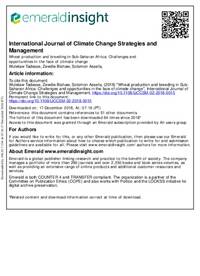Wheat production and breeding in Sub-Saharan Africa: Challenges and opportunities in the face of climate change

Authors:
Purpose – This paper aims to review the current status of wheat production, farming systems, production constraints and wheat demand-supply chain analysis; the role of international and national breeding programs and their approaches in wheat genetic improvement including targeting mega environments, shuttle breeding, doubled haploids, marker-assisted selection and key location phenotyping; and future prospects and opportunities of wheat production in Sub Saharan Africa (SSA).
Design/methodology/approach – Relevant literature works have been used and cited accordingly.
Findings – Though traditionally wheat was not the leading staple crop in SSA, it is becoming an important food crop because of rapid population growth associated with increased urbanization and change in food preference for easy and fast food such as bread, biscuits, pasta, noodles and porridge. In 2013, total wheat consumption in SSA reached 25 million tons with import accounting for 17.5 million tons at a price of USD 6 billion, while during the same period the region produces only 7.3 million tons on a total area of 2.9 million hectares. The low productivity (2t/ha) in the region is principally because of abiotic (drought and heat) and biotic (yellow rust, stem rust, septoria and fusarium) stresses which are increasing in intensity and frequency associated with climate change. Furthermore, increased cost of production, growing populations, increased rural-urban migration, low public and private investments, weak extension systems and policies, and low adoption rates of new technologies remain to be major challenges for wheat production in SSA. Wheat breeding in SSA is dominantly carried out by National Agricultural Research Systems, in partnership with the international research centers [International center for improvement of maize and wheat (CIMMYT) and International center for agricultural research in the dry areas (ICARDA),to develop high yielding and widely adapted wheat genotypes with increased water-use efficiency, heat tolerance and resistance to major diseases and pests. Most of the cultivars grown in SSA are originated from the international research centers, CIMMYT and ICARDA.
Practical implications – This paper will help to promote available wheat technologies in SSA by creating awareness to wheat scientists,extension agents and policymakers.
